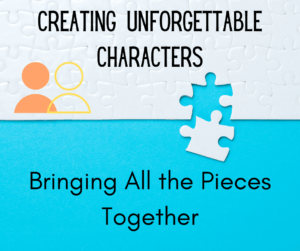
Unforgettable characters—they live our heads. But can we convey wheat they mean to us effectively onto the page?
Of course! To connect readers to your characters, your primary, secondary, and tertiary characters have to do their jobs effectively. They must have purpose and add something to your story. Over time, with a story or series, they may even develop or require a character arc.
A good rule to follow is if you name them, they need a character bio worksheet.
It’s time to wrap up this series! In the first four articles, we’ve explored how to create and use a well-developed cast of characters. This final segment will discuss resources to help you.
My Favorite Tools
If you’re falling flat, no worries! There are many ways to bulk up your characters to make their time on the page compelling. Here are some strategies I employ:
- 2-3 Key Moments that shape the character
- Decide what caused your character to act or think the way they do. Continually ask “why?” Is your character overly friendly? Why? Well, s/he doesn’t want to be lonely. Why? Because s/he is an only child living with elderly relatives after his/her parents left. Why? The parents were running from an enemy that would surely kill the child. Why? Because the child is the Chosen One.
- Key moments may include watching the parents leave, being locked in the house or a room for an extended amount of time, going to school and learning what freedom can look and feel like, and being rejected by someone the character thought was their true friend.
- Diary Entries to get into the character’s shoes/current state of mind
- Pretending you’re someone else in the first person point of view can often help you get into their heads. Several authors I know who write in third person will often switch to first person to get a scene out, and then rewrite it.
- Journaling (at time of wound)
- This was super helpful to me when I needed to get inside the head of my heroine in Love on the Beach. I pretended I was Shelby, watching her mother get hit by a drunk driver and die before my eyes. I needed to feel the deepest kind of grief myself so that I could convey it to the reader. I recalled what losing my grandmother had been like. After that, journaling in Shelby’s perspective helped me write to her scenes because I was there with her experiencing the grief.
- Florida romance author Priscilla Oliveras recorded a two-minute video explaining the technique and its merits.
- Interview
- If you’re like me, your characters talk to you, so why not flip the switch on them? This gets really fun, and sometimes surprising! The hero in Love on the Rocks can’t help but rescue every stray animal he comes across. My intent was to give him a dog. It wasn’t meant to be – he found a baby harbor seal instead.
- Ask your character to explain him or herself and how they felt about a particular event during the creation of their wound, key moments, or about another character.
- Craft Books
- There are so many! I recommend a few that have helped get me unstuck:
- Thesaurus Series (Writers Helping Writers) by Becca Puglisi and Angela Ackerman contains helpful lists such as emotions, emotional wounds, negative traits, positive traits, and more.
- The Story Equation by Susan May Warren. Through character development, she explains the necessary elements every story must have.
- Story Genius by Lisa Cron explores the brain science of story, and how to connect to readers by giving them what their brains have been trained to expect.
- There are so many! I recommend a few that have helped get me unstuck:
The Power of Series
Have you ever read a book and wished it would continue? Why? Was it the world or the characters that drew you in? I would argue that a well-built world is a character in its own right.
This is what brings series readers back again and again to the same author, characters and world. Kat Mizera’s best-selling awarding-winning books are all linked, with crossover novels featuring secondary-to-primary heroes and heroines to entice readers to the spinoffs.
“I don’t specifically create memorable individual characters, though that happens organically much of the time, but I strive to create memorable relationships outside of the romance. The friendships and family bonds [in the Las Vegas Sidewinders and Alaska Blizzard series] are what bring readers back to my series every time. They know everyone in the series is going to be there in a crisis, and they look for those continued relationships.” –Kat Mizera
In addition to the two series mentioned above, there is Sidewinders Generations, a Rock Star Trilogy, a Greece trilogy, and her new Royal Protectors series that brings in characters from several of the other series.
Worth the Effort
It takes a lot of hard work to create a memorable character, never mind an entire cast of them! It may seem daunting, but readers connecting your characters and loving them as much as you do?
Priceless.
